You’re rummaging through your grandmother’s china cabinet, and there it is, a stunning crystal glass that catches the light just so, creating a mesmerizing rainbow of reflections across your dining room.
But as you turn it over in your hands, you notice some peculiar markings at the base. What stories do these enigmatic crystal markings tell? What secrets about your family’s heritage might they unlock?
For countless collectors and inherited treasure keepers, these mysterious marks hold the key to understanding not just the value of their pieces but their authentic history and legacy.
As you embark on this journey of discovery, you’ll soon realize that these seemingly simple marks are anything but – they’re the crystalline fingerprints that can transform your curious findings into verified treasures.
UNDERSTANDING GLASS VS CRYSTAL: THE FUNDAMENTAL DIFFERENCES
Before diving into identification markings, it’s essential to understand what distinguishes crystal from regular glass.
This knowledge forms the foundation for proper identification and helps explain why certain pieces are marked differently.
Physical and Chemical Composition
Regular Glass:
- Made from silica (sand), soda ash, and limestone
- Contains no lead oxide
- Melting point around 1400-1600°C
- Lower refractive index (typically 1.5)
- Less brilliant appearance
Crystal Glass:
- Contains a minimum of 24% lead oxide (PbO) for traditional lead crystal
- Higher melting point requires specialized manufacturing
- Refractive index of 1.545 or higher
- Superior brilliance and light dispersion
- Distinct resonance when tapped
Lead-Free Crystal Alternatives: Modern manufacturers now produce lead-free crystal using:
- Zinc oxide
- Potassium oxide
- Barium oxide. These materials achieve similar optical properties while addressing health and environmental concerns.
Key Property Comparisons
Optical Properties: Crystal’s higher lead content creates superior light refraction, producing the characteristic “sparkle” and rainbow effects that glass cannot replicate.
This prismatic quality is one of the most reliable identification features.
Weight and Density: Crystal is significantly heavier than glass of the same size due to lead content. This weight difference is immediately noticeable when handling pieces and serves as a quick preliminary test.
Sound Characteristics: When gently struck, the crystal produces a clear, sustained ringing tone that can last several seconds.
Glass creates a duller, shorter sound. This acoustic difference results from the crystal’s molecular structure.
Durability: Despite common misconceptions, quality crystal is more durable than regular glass. The lead content makes it more resistant to chipping and allows for deeper, more precise cutting without fracturing.
GLASS MARKINGS IDENTIFICATION
While crystal markings often receive more attention, understanding glass markings is equally important for comprehensive identification, especially when distinguishing between the two materials.
Common Glass Manufacturer Marks
Pressed Glass Makers:
- Anchor Hocking: Anchor symbol or “AH” monogram
- Federal Glass Company: “F” in shield
- Hazel Atlas: “HA” or “A” in circle
- Indiana Glass: “IG” or diamond mark
- Jeannette Glass: “J” in triangle
Art Glass Manufacturers:
- Fenton: “Fenton” in script or oval logo
- Imperial Glass: “IG” or crossed swords mark
- Westmoreland: “WG” intertwined letters
- Cambridge Glass: “C” in triangle
- Heisey Glass: Diamond “H” mark
Glass Marking Characteristics
Unlike crystal marks, glass markings are often:
- Molded directly into the piece during manufacturing
- Located at the bottom in a raised or recessed format
- Simpler in design with less ornate styling
- Sometimes include mold numbers or pattern codes
- May feature date codes in numerical format
Identifying Unmarked Glass
Many vintage glass pieces lack manufacturer marks. Identify them through:
- Pattern recognition and research
- Manufacturing technique examination (mold lines, seams)
- Color and treatment (depression glass, milk glass, carnival glass)
- Design era characteristics (Art Deco, Mid-Century Modern)
- Weight and thickness patterns.
GLASS TYPES AND PROPERTIES COMPARISON
Understanding different glass types helps narrow down identification and determine appropriate valuation.
Depression Glass (1920s-1940s)
Characteristics:
- Mass-produced, affordable tableware
- Distinctive pastel colors (pink, green, amber, clear)
- Often distributed as premiums or giveaways
- Machine-pressed patterns
- Usually marked with mold numbers rather than maker’s marks
Common Patterns: Depression glass comes in hundreds of patterns, many unnamed by manufacturers. Pattern identification guides are essential for proper attribution.
Milk Glass (1800s-1970s)
Characteristics:
- Opaque white appearance
- Made with bone ash, tin oxide, or fluorides
- Popular for decorative pieces and serving ware
- Often features hand-painted or fired-on decorations
- Markers include Westmoreland, Fenton, Imperial
Cut Glass (1880s-1920s)
Characteristics:
- Hand-cut geometric patterns
- American Brilliant Period (1876-1916) represents the peak production
- Deep, precise cuts with sharp edges
- Heavy weight
- Often unmarked or with small acid signatures
Carnival Glass (1907-1930s)
Characteristics:
- Iridescent surface treatment
- Mass-produced pressed glass
- Wide range of colors and patterns
- Most pieces unmarked
- Manufacturers include Northwood, Fenton, Imperial, and Millersburg
CRYSTAL GLASS MARKS IDENTIFICATION CHART
A crystal glass marks identification chart is a reference guide that catalogs the various markings, signatures, and logos used by crystal and glassware manufacturers. These charts typically include:
- Manufacturer signatures: Renowned crystal manufacturers normally mark their pieces with a logo, name, or signature on the bottom
- Dating codes: Numbers or letters indicating production periods
- Pattern marks: Specific identifiers for particular designs
- Quality marks: Indicators of lead content or craftsmanship level
- Country of origin marks: Required by law in many jurisdictions
Common manufacturers featured in these charts include Waterford, Baccarat, Lalique, Steuben, and others, each with distinctive marking systems.
VINTAGE CRYSTAL GLASS MARKS IDENTIFICATION CHART
Vintage crystal identification charts focus specifically on older pieces, typically pre-1960s, and include:
- Early manufacturer marks: Often simpler designs than modern equivalents
- Paper labels: Many vintage pieces used adhesive labels that may have fallen off
- Engraved signatures: Hand-etched marks common in the early 20th century
- Regional variations: Different marks used for export vs. domestic markets
- Discontinued manufacturers: Companies no longer in business
Vintage marks often require magnification and careful examination due to age-related wear.
UNDERSTANDING THE LANGUAGE OF CRYSTAL MARKS
Crystal markings are rather like the DNA of fine glassware – they tell us everything from the piece’s origin to its age and authenticity.
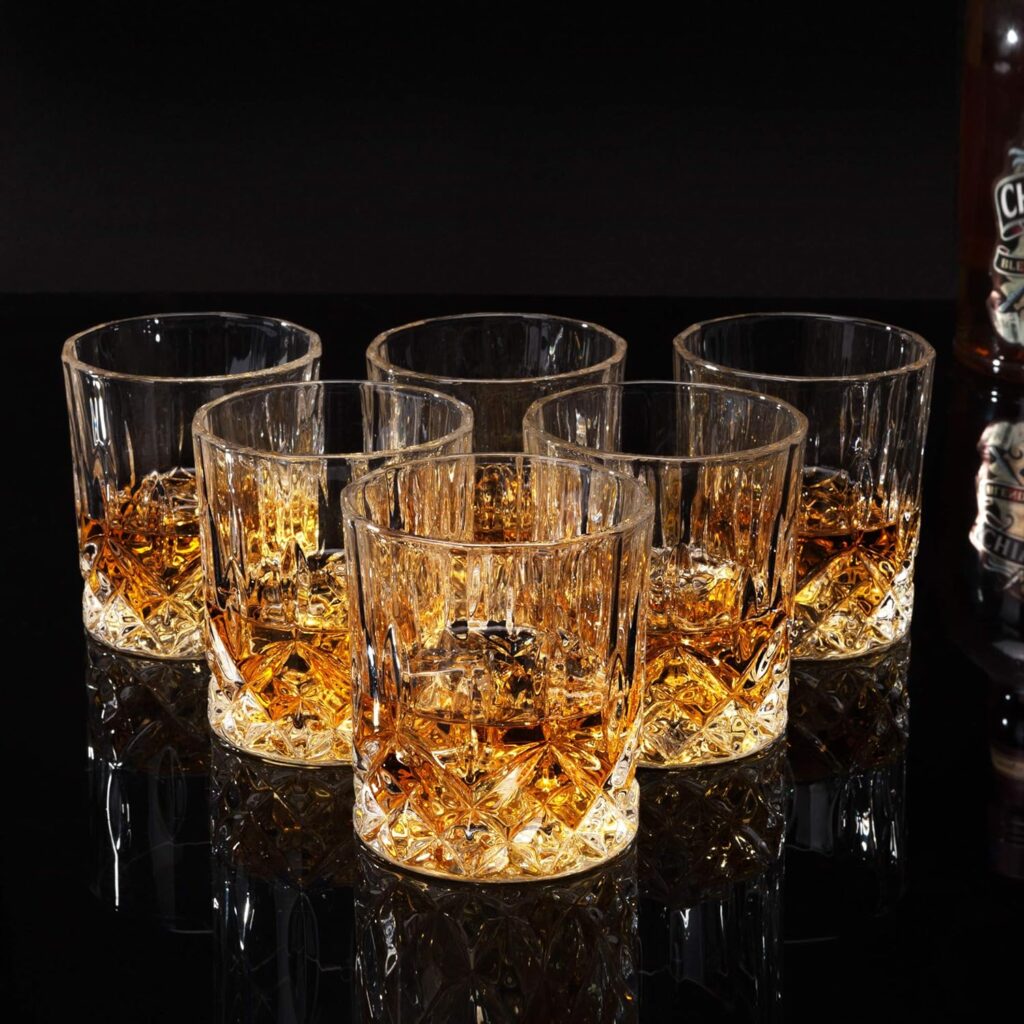
Just as Waterford crystal markings have their distinctive characteristics, each manufacturer has developed their own unique “signature” over time.
These marks aren’t just random scratches or logos; they’re carefully crafted identifiers that speak volumes to those who know how to read them.
WHAT IS CRYSTAL GLASSWARE MADE OF?
Before diving into identification, it’s essential to understand what sets crystal apart from ordinary glass.

Crystal glassware contains a minimum of 24% lead oxide (PbO), which gives it its distinctive properties:
– Enhanced clarity and brilliance
– Greater light refraction
– Increased durability
– Superior resonance when “clinked”
– Higher weight than regular glass
Modern lead-free crystal alternatives use minerals like zinc oxide or potassium oxide to achieve similar characteristics while being more environmentally friendly.
CRYSTAL GLASS MAKERS MARKS
Major crystal manufacturers use distinctive marking systems:
- Waterford: Acid-etched “WATERFORD” or seahorse logo
- Baccarat: Typically shows “Baccarat France” in script
- Lalique: Usually signed “Lalique France”
- Steuben: Often features “Steuben” in block letters
- Moser: Moser often marks their pieces with their brand name
- Royal Doulton: Various marks, including crown symbols
- Orrefors: Swedish maker with distinctive marking
Each manufacturer has evolved their marking system over time, making dating possible through mark variations.
LEAD CRYSTAL MAKERS MARKS
Leading manufacturers of lead crystal use specific marking systems:
Premium Brands:
- Waterford (Ireland): Acid-etched marks, seahorse logo
- Baccarat (France): Script signature, often with “France”
- Lalique (France): Distinctive signature, sometimes with “R” for René
- Steuben (USA): Block letter marking
- Royal Doulton (England): Crown symbols and text.
Quality Indicators:
- Many marks include lead content percentage
- “Full Lead Crystal” indicates 24%+ lead content
- The country of origin is often included for export compliance.
PREMIUM CRYSTAL BRAND IDENTIFICATION GUIDES
Understanding the distinctions between major crystal brands helps collectors make informed decisions and properly identify pieces in their collections.
Waterford Crystal Identification
Waterford remains one of the most recognized crystal brands worldwide. Key identification features include:
Waterford Markings Evolution:
- Pre-1999: Acid-etched “WATERFORD” in serif font
- 1999-2000: Introduction of the seahorse logo
- 2000-present: Seahorse mark standard on most pieces
- Some pieces feature both the company name and logo
Waterford Patterns: To learn more about Waterford Crystal Patterns, check our comprehensive guide on Waterford Goblet Patterns – detailed pattern identification and Waterford Marquis Patterns – sub-brand pattern guide.
Distinguishing Waterford Quality:
- Exceptional clarity and brilliance
- Deep, precise cutting
- Substantial weight
- Sharp, well-defined edges
- Consistent pattern execution
Baccarat Crystal Identification
French luxury crystal manufacturer Baccarat has been producing exquisite pieces since 1764.
Baccarat Marking Systems:
- Paper labels (often lost on vintage pieces)
- Acid-etched “Baccarat” in script
- Circular mark with “Baccarat France”
- Registration marks for specific periods
Baccarat Characteristics:
- Exceptional optical clarity
- Innovative cutting techniques
- Distinctive French design aesthetic
- Often features intricate gilding or enameling
- Premium pricing reflects superior craftsmanship
Dating Baccarat Pieces:
- Pre-1936: Often unmarked or paper labels only
- 1936-1970s: Acid-etched marks introduced
- 1970s-present: Consistent marking with registration symbols
Ajka Crystal Identification
Hungarian manufacturer Ajka produces high-quality crystal with distinctive characteristics.
Ajka Marking Features:
- “Ajka Crystal” acid-etched mark
- “Hand Cut in Hungary” designation
- Quality indicators for lead content
- Pattern names in some collections
Ajka Quality Indicators:
- 24% lead crystal content
- Hand-cutting techniques
- European design influences
- Competitive pricing for quality level
Other Notable Crystal Manufacturers
Steuben (American):
- Art glass and crystal since 1903
- “Steuben” in block letters
- Known for sculptural pieces
- High collectibility for vintage pieces
Moser (Bohemian/Czech):
- Richly colored crystal
- Elaborate decoration techniques
- “Moser” signature or applied mark
- Combines cutting with gilding and enameling
Orrefors (Swedish):
- Scandinavian design aesthetic
- “Orrefors” etched signature
- Known for Graal and Ariel techniques
- Artist signatures on art pieces
Royal Doulton Crystal:
- British manufacturer
- Various marks, including crown symbols
- “Royal Doulton Crystal” text marks
- Pattern names are often included.
BRAND COMPARISON GUIDES
Understanding how different crystal brands compare helps collectors make informed purchasing decisions and properly value their pieces.
Waterford vs Marquis: Understanding the Difference
See our comprehensive guide on Waterford vs Marquis Complete Comparison – pricing, quality, and value analysis.
Waterford (Main Line):
- Premium pricing
- Hand-cut in Ireland (traditionally)
- Full lead crystal (24%+ lead oxide)
- Intricate, complex patterns
- Seahorse mark
Marquis by Waterford:
- More affordable price point
- Machine-cut with hand-finishing
- Crystal composition varies by line
- Simpler patterns adapted from Waterford designs
- “Marquis by Waterford” marking
Value Considerations:
- Waterford’s main line commands 2-3x higher resale value
- Marquis offers an accessible entry point for crystal collecting
- Both maintain quality standards for durability
- Pattern complexity affects pricing within each line
European vs American Crystal Characteristics
European Crystal (Baccarat, Ajka, Moser, Waterford):
- Traditional cutting techniques
- Ornate, elaborate patterns
- Strong historical lineage
- Higher lead content standards
- Premium market positioning
American Crystal (Steuben, Lenox):
- Often emphasizes sculptural forms
- Cleaner, more modern aesthetics
- Innovation in manufacturing techniques
- Art glass tradition influence
- Varied market positioning.
CRYSTAL PATTERN IDENTIFICATION
Pattern recognition is crucial for completing sets, determining value, and proper authentication.
Pattern Documentation Resources
Manufacturer Catalogs:
- Original catalogs provide definitive pattern names
- Dating information through catalog publication dates
- Piece availability and original pricing
- Pattern variation documentation
Online Databases:
- Collector websites maintain pattern libraries
- User-submitted photographs aid identification
- Discussion forums for difficult identifications
- Cross-referencing capabilities
Common Pattern Categories
Cut Crystal Patterns:
- Geometric designs (diamonds, crosshatching, fans)
- Floral motifs
- Architectural elements
- Abstract modern designs
Etched Crystal Patterns:
- Acid-etched decorative designs
- Often feature naturalistic scenes
- Lighter, more delicate appearance
- Popular in stemware
Combined Techniques:
- Cutting and etching together
- Gilding or enameling additions
- Multiple pattern elements
- More valuable due to complexity
Waterford Pattern Identification
Classic Waterford Patterns:
- Lismore (1952-present): Most iconic pattern
- Colleen (1953): Short and tall stem variations
- Tramore (1968): Vertical cutting style
- Araglin (1976): Contemporary design
- Powerscourt (1969): Bold, geometric
Dating Through Patterns:
- Introduction dates narrow production timeline
- Discontinued patterns increase collectibility
- Pattern variations indicate production periods.
HOW TO IDENTIFY CRYSTAL GLASSWARE
To identify crystal glassware effectively:
Location of Marks: You could find the mark on the rim or center of the foot, on the stem, or on the bottom of the bowl. The mark could be an initial, a logo, a word, or coded numbers and letters
Examination Techniques: A magnifying glass and holding the stemware up to light can help you spot the mark and read it
Physical Tests:
- Sound test: Crystal will have a pleasant pinging noise, while glass will thunk
- Light refraction: A Crystal may refract the light and create prismatic effects
- Weight: Crystal feels heavier due to the lead content
- Temperature: Crystal feels cooler to the touch initially.
HOW TO IDENTIFY UNMARKED CRYSTAL?
When a crystal lacks visible markings, use these identification methods:
Physical Properties:
- The easiest method to determine if a crystal is to see if it forms prisms and makes a bell sound when gently tapped
- Lead content test: Due to the lead content, the crystal will have a blue or purple tint to it, whereas the glass just looks a dull green color under black light
- Thickness examination: Crystal typically has thinner, more refined edges
- Clarity: Superior optical clarity compared to regular glass
Style and Pattern Analysis:
- Research characteristic design elements of known manufacturers
- Compare proportions and cutting patterns
- Consider the complexity and precision of cuts
- Evaluate overall craftsmanship quality.
HOW TO IDENTIFY LEAD CRYSTAL VASE
To identify a lead crystal vase:
Physical Tests:
- Take a butter knife or other metal utensil and gently tap the glass; if it makes a drawn-out ringing sound, it is more than likely crystal
- Weight test: Lead crystal vases are noticeably heavier than glass
- Light test: Hold up to the light to check for brilliant refraction
- Temperature test: Feels cool initially, then warms in the hand
Visual Inspection:
- Look for manufacturer marks on the base
- Examine cut patterns for precision and depth
- Check for optical clarity and brilliance
- Assess overall craftsmanship quality.
HOW TO TELL IF IT’S REAL CRYSTAL?
There are several foolproof methods to distinguish genuine crystal from regular glass:

The Ring Test
Hold the glass by the stem and gently flick it with your finger:
– Crystal produces a clear, resonant chime
– Regular glass makes a dull, short-lived ‘clink’
The Light Test
Hold the piece up to a light source:
– Crystal creates prismatic rainbows
– Regular glass produces simple reflections
The Weight Test
Compare similar pieces:
– Crystal feels noticeably heavier
– Regular glass feels lighter and less substantial.
CRYSTAL SAFETY: LEAD CONTENT CONCERNS
Understanding lead content in crystal is essential for safe use and informed collecting decisions.
Lead Crystal Safety Guidelines
Daily Use Considerations:
- Avoid storing acidic beverages (wine, juice) in lead crystal long-term
- Don’t use lead crystal for children’s drinkware
- Minimize daily use of lead crystal for food service
- Lead-free crystal alternatives are available for frequent use
Lead Content Testing: Kindly read our comprehensive resource on: Does Waterford Crystal Contain Lead – a comprehensive safety guide.
- Home test kits available for lead detection
- Professional testing for valuable pieces
- Manufacturer specifications provide the lead percentage
- Vintage pieces may have higher lead content
Health Recommendations:
- Occasional use of lead crystal poses minimal risk
- Lead leaching increases with acidic contents and extended storage
- Decorative display carries no health concerns
- Follow FDA guidelines for food-safe glassware
Lead-Free Crystal Alternatives
Modern Formulations:
- Zinc oxide crystal
- Potassium oxide crystal
- Barium oxide crystal
- Titanium oxide additions
Performance Comparison:
- Optical properties are nearly identical to lead crystal
- Slightly different resonance characteristics
- Equal durability for cutting and use
- No health concerns for food service
Brand Offerings: Many traditional manufacturers now offer lead-free lines while maintaining their lead crystal heritage collections.
THE EVOLUTION OF CRYSTAL MARKING METHODS
Throughout history, manufacturers have employed various techniques to mark their crystal pieces:
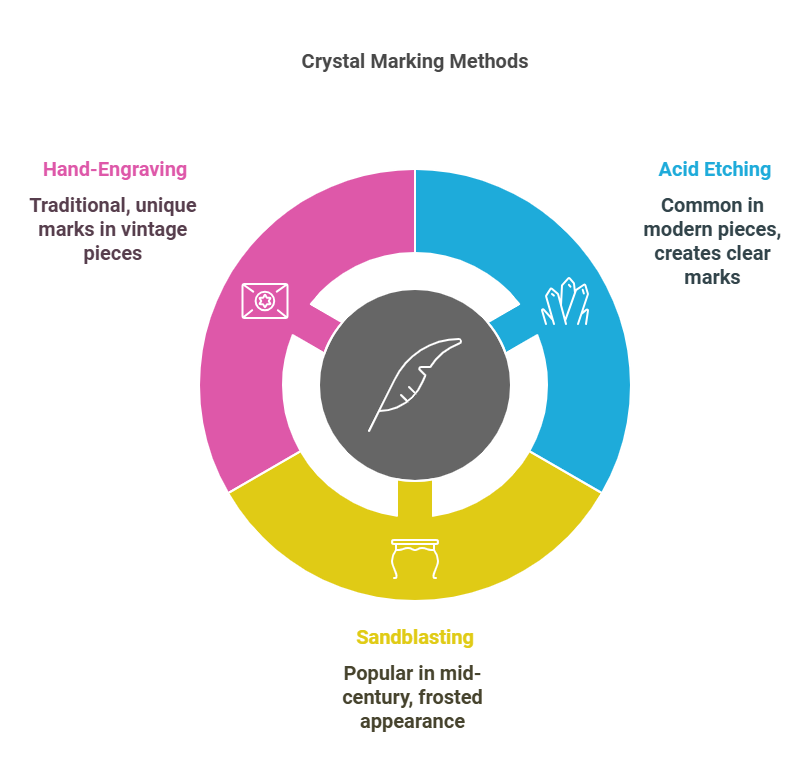
1. Acid Etching
– Most common in modern pieces
– Creates clear, precise marks
– Usually found on the bottom of the piece
2. Sandblasting
– Popular in mid-century pieces
– Creates a frosted appearance
– Often used for larger marks
3. Hand-Engraving
– Traditional method
– Each mark is unique
– Found in vintage and antique pieces
COMMON TYPES OF CRYSTAL MARKS
Understanding different types of marks is crucial for proper identification. While some collectors might be familiar with identifying Mikasa crystal marks, each manufacturer has its distinctive style.
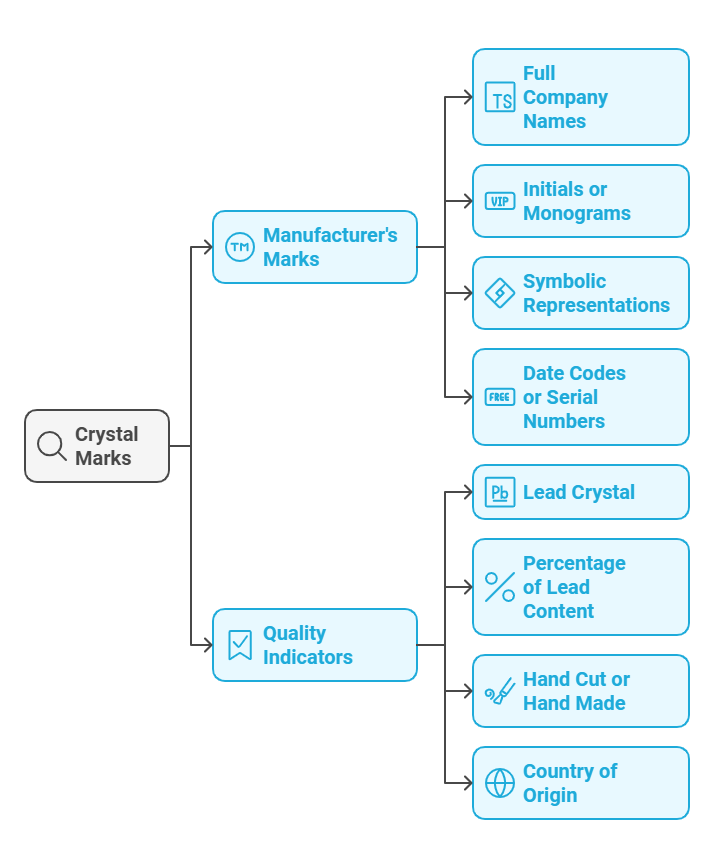
Manufacturer’s Marks
The most common type of crystal marking is the manufacturer’s signature or logo. These can appear as:
– Full company names
– Initials or monograms
– Symbolic representations
– Date codes or serial numbers
Quality Indicators
Quality marks often appear alongside the manufacturer’s marks and can include:
– “Lead Crystal” or “Full Lead Crystal”
– Percentage of lead content (24% PbO)
– “Hand Cut” or “Hand Made”
– Country of origin
READING AND INTERPRETING CRYSTAL MARKS
Much like Fiestaware with markings, crystal pieces tell their stories through various symbols and codes.
Here’s how to decode them:
Step-by-Step Authentication Process
1. Clean the piece carefully
– Use a soft, lint-free cloth
– Avoid harsh chemicals
– Ensure proper lighting
2. Locate the marking
– Check the base
– Look for marks on the stem
– Examine the rim
3. Document what you find
– Photograph the marks
– Note their location
– Measure their size
Table: Common Manufacturer Marks and Their Meanings
| Manufacturer | Common Marks | Years Used | Notable Features |
| Waterford | Acid-etched seahorse | 1950-present | Bold, clear etching |
| Mikasa | “M” in crystal | 1970-present | Often includes a year code |
| Lalique | “R. LALIQUE” | 1925-1945 | Cursive script |
| Baccarat | Registered trademark symbol | 1936-present | Often includes year code |
CRYSTAL MARKINGS ON GLASSWARE
Below are the various ways manufacturers employ to mark their glass products.
Techniques and common locations include:
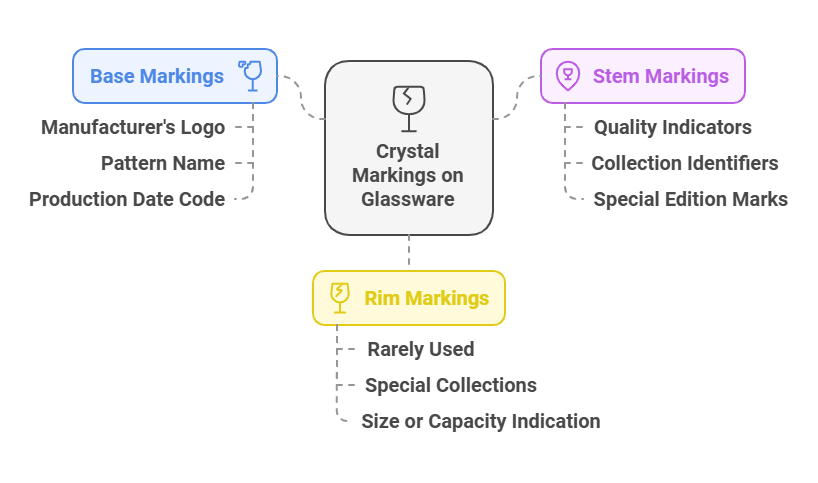
1. Base Markings
– Manufacturer’s logo
– Pattern name
– Production date code
2. Stem Markings
– Quality indicators
– Collection identifiers
– Special edition marks
3. Rim Markings
– Rarely used
– Usually denotes special collections
– Sometimes indicates size or capacity.
CRYSTAL STEMWARE IDENTIFICATION GUIDELINES
Just as collectors learn about various ways of identifying various glassware brands, here are the specific guidelines that exist for stemware identification:
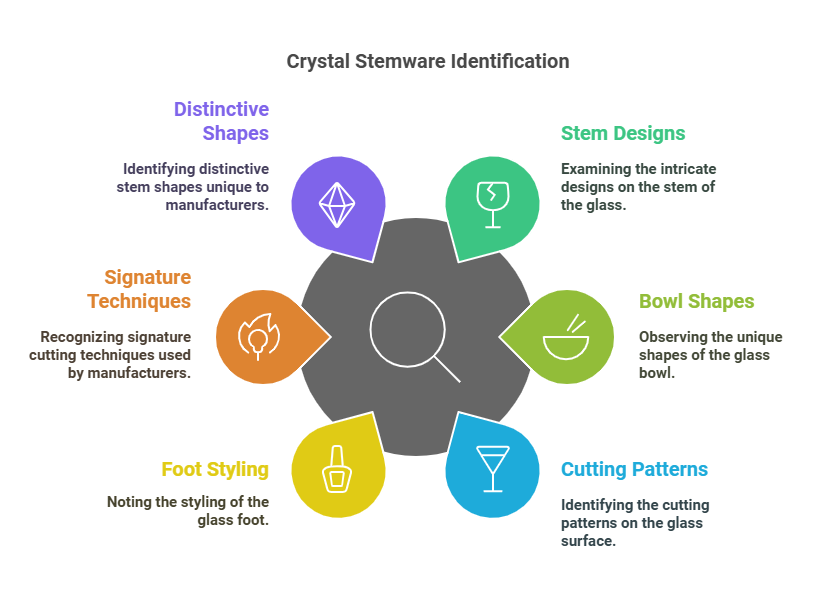
Pattern Recognition
– Study stem designs
– Note bowl shapes
– Examine cutting patterns
– Compare foot styling
Manufacturer-Specific Features
– Signature cutting techniques
– Distinctive stem shapes
– Unique marking placements
HOW TO IDENTIFY GLASS MARKINGS VS CRYSTAL MARKS
Glass and crystal markings differ in several key ways:

Glass Markings Characteristics
– Often molded into the piece
– Less detailed
– Usually simpler logos
– Factory codes are common
Crystal Marks Characteristics
– Usually acid-etched or hand-engraved
– More intricate details
– Complex maker’s marks
– Quality indicators present
DATING YOUR CRYSTAL THROUGH MARKS

Understanding the age of your crystal involves more than just reading the marks.
Consider these factors:
Period-Specific Characteristics
– Pre-1900: Often hand-engraved marks
– 1900-1950: Introduction of acid etching
– 1950-present: Combination of methods
HOW TO IDENTIFY VINTAGE ETCHED GLASSWARE?
1. Examine the Etching
– Hand-etched pieces show slight irregularities
– Machine-etched patterns are perfectly uniform
– Period-specific motifs help date pieces
2. Study the Pattern
– Record pattern names
– Research production dates
– Note any pattern variations
HOW TO TELL IF GLASSWARE IS VINTAGE OR ANTIQUE
1. Age Indicators
– Wear patterns on the base
– Style of cutting
– Type of glass composition
2. Manufacturing Techniques
– Hand-finishing marks
– Pontil marks
– Mould lines.
HOW TO TELL IF A VASE IS CRYSTAL?
To determine if a vase is crystal rather than glass:
Sound Test: The lead content, weight, rim thickness, and UV reaction. The easiest method to determine if a crystal is to see if it forms prisms and makes a bell sound when gently tapped
Visual Tests:
- Optical clarity: Crystal appears more brilliant and clear
- Light refraction: Creates rainbow effects when light passes through
- Edge examination: Crystal has sharper, more precise edges
- Cut quality: Deeper, more precise cuts with better finishing
Physical Properties:
- Weight: Significantly heavier than the equivalent glass piece
- Temperature: Cooler initial touch, slower to warm
- Durability: More resistant to chipping and scratching
UV Light Test: One of the best ways to identify a crystal is to shine a black light on it.
Due to the lead content, the crystal will have a blue or purple tint to it, whereas the glass just looks a dull green color under black light
These identification methods, when used together, provide reliable ways to distinguish genuine crystal from regular glass and identify specific manufacturers, even when dealing with unmarked pieces.
The combination of physical testing, visual examination, and mark identification creates a comprehensive approach to crystal authentication and valuation.
AUTHENTICATION AND AVOIDING REPRODUCTIONS
With valuable crystal pieces commanding premium prices, reproductions and fakes have entered the market. Understanding authentication is essential for collectors.
Common Reproduction Red Flags
Marking Inconsistencies:
- Marks that don’t match documented examples
- Poorly executed etching or engraving
- Marks in unusual locations
- Modern techniques on “vintage” pieces
Quality Issues:
- Lower quality cutting (shallow, imprecise)
- Inferior optical clarity
- Lighter weight than authentic pieces
- Machine-made characteristics on supposedly hand-cut items
Documentation Problems:
- Lack of provenance for rare pieces
- Suspicious pricing (too good to be true)
- The seller is unable to provide the history
- Missing pattern documentation
Professional Authentication Services
When to Seek Expert Opinion:
- High-value purchases
- Rare or unusual pieces
- Uncertain attribution
- Insurance or estate purposes
Authentication Resources:
- Certified appraisers specializing in crystal
- Auction house experts
- Manufacturer authentication services
- Crystal collector associations
Building Authentication Skills
Study Authentic Examples:
- Visit museum collections
- Attend antique shows and auctions
- Join collector groups and forums
- Build a reference library of manufacturer materials
Develop Comparative Eye:
- Handle both authentic and reproduction pieces
- Study marking techniques up close
- Learn period-appropriate characteristics
- Understand manufacturing evolution.
CARE AND PRESERVATION OF MARKED CRYSTAL
To maintain the legibility of crystal marks:
1. Proper Cleaning
– Use lukewarm water
– Avoid abrasive materials
– Pat dry immediately
2. Storage Recommendations
– Store pieces separately
– Avoid stacking
– Keep away from direct sunlight.
CRYSTAL MARKS INDEX
A Crystal Marks Index is a comprehensive reference system (systematic database) that catalogs and organizes the various markings, signatures, and identifying features used by crystal and glassware manufacturers throughout history.
This specialized index serves as an essential tool for collectors, dealers, appraisers, and enthusiasts to identify and authenticate crystal pieces. It includes:
Manufacturer Signatures: A collection of signatures and markings that can be found on many types of antique and vintage collectable glassware.
Organizational Structure: The index typically organizes information by:
- Alphabetical listing by manufacturer name
- Chronological dating systems
- Geographic origin (country/region)
- Mark type (etched, molded, paper labels)
- Product categories (stemware, vases, decorative pieces)
COMPONENTS OF A CRYSTAL MARKS INDEX
Visual Documentation:
- High-resolution images of actual marks
- Line drawings for unclear or worn marks
- Scale references for mark sizing
- Multiple angles when the marks vary in appearance
Manufacturer Information:
- Company history and operational dates
- Location of production facilities
- Mark evolution timeline
- Pattern names and numbers
Dating Systems:
- Production period indicators
- Mark variations by decade
- Special edition or limited production marks
- Discontinued mark identification.
TYPES OF CRYSTAL MARKS INDEXED
Acid-Etched Marks: Permanent marks created using acid during manufacturing.
Molded Marks: Integrated into the glass during the forming process.
Paper Labels: Adhesive labels (often missing on vintage pieces).
Engraved Signatures: Hand-etched or machine-engraved identifiers.
Pattern Numbers: Numerical codes for specific designs.
Quality Indicators: Lead content percentages, craftsmanship levels.
HOW TO USE A CRYSTAL MARKS INDEX
Step-by-Step Process:
- Locate the Mark: You could find the mark on the rim or center of the foot, on the stem, or on the bottom of the bowl
- Examine Carefully: A magnifying glass and holding the stemware up to the light can help you spot the mark and read it
- Cross-Reference: Match found marks with index entries
- Verify Details: Confirm manufacturer, dating, and authenticity.
PROFESSIONAL CRYSTAL MARKS INDEX RESOURCES
Published Guides: The most extensive stemware guide ever published, this is an ideal reference guide for the thousands of glass dealers across the country who search for the many patterns of etched, plain, blown, or molded designs.
Digital Databases: A searchable database of antique + collectable glassware, with pictures, sizes + pattern numbers of vintage glass from all over the world.
Specialized Collections: Many indexes focus on specific aspects such as:
- Stemware patterns exclusively
- Regional manufacturers
- Specific time periods
- Particular crystal types.
BENEFITS OF USING A CRYSTAL MARKS INDEX
Authentication: Verify genuine pieces versus reproductions.
Valuation: Determine market value through proper identification.
Dating: Establish production periods and historical context.
Pattern Identification: Match pieces to complete sets.
Educational Research: Learn about manufacturer histories and techniques.
LIMITATIONS AND CONSIDERATIONS
Unmarked Pieces: Many authentic vintage pieces lack marks entirely.
Worn Marks: Age and handling can obscure or remove markings.
Counterfeit Marks: Modern reproductions may include fake marks.
Incomplete Records: Some smaller manufacturers may not be well-documented.
CREATING YOUR OWN CRYSTAL MARKS REFERENCE
For serious collectors, maintaining a personal crystal marks index can include:
- Photography of pieces in your collection
- Detailed notes on acquisition and provenance
- Cross-references to published guides
- Documentation of any unique or unusual marks
A Crystal Marks Index serves as an indispensable tool in the world of crystal collecting and identification, providing the systematic approach needed to properly authenticate, date, and value crystal glassware.
Whether used by professional dealers or passionate collectors, these indexes represent decades of accumulated knowledge about the artistry and craftsmanship of crystal manufacturing.
This comprehensive reference system transforms what might otherwise be mysterious markings into valuable information that unlocks the history, origin, and significance of crystal pieces, making it an essential component of any serious crystal identification library.
CRYSTAL AND GLASS VALUATION FACTORS
Beyond identification, understanding what drives value helps collectors make informed decisions about purchases, sales, and insurance.
Primary Value Determinants
Manufacturer Prestige:
- Heritage brands command premium pricing
- Company history and reputation matter
- Limited production makes manufacturers more valuable
- Artist-signed pieces increase their worth significantly
Age and Rarity:
- Antique pieces (100+ years) are often most valuable
- Discontinued patterns are harder to find
- Limited editions and commemoratives
- Short production runs increase scarcity
Condition Assessment:
- Mint condition is critical for maximum value
- Even minor chips reduce the value by 30-50%
- Cloudiness from dishwasher damage decreases the worth
- Original boxes and documentation add value
Pattern Complexity:
- Intricate cutting commands higher prices
- Combined techniques (cutting + etching) more valuable
- Hand-finishing versus machine-cutting affects pricing
- Pattern popularity influences market demand
Completeness:
- Full sets are worth more than the sum of parts
- Rare serving pieces command a premium
- Mixed pattern sets are less valuable
- Size of set affects per-piece value
Market Trends and Collecting
Current Market Observations:
- Mid-century crystal is seeing renewed interest
- Younger collectors prefer modern, simpler patterns
- Vintage colored crystal is gaining popularity
- Scandinavian designs are increasingly sought-after
Investment Considerations:
- Crystal is primarily collectible, not investment-grade
- Buy what you love and will use or display
- The market fluctuates with design trends
- Condition paramount for value retention.
IS CRYSTAL GLASSWARE WORTH ANYTHING?
The value of crystal glassware depends on several factors:
Value Determinants
1. Manufacturer Prestige
– High-end makers command premium prices
– Limited editions increase value
– Historical significance matters
2. Condition
– Mint condition pieces fetch the highest prices
– Original packaging adds value
– Documentation increases worth
3. Rarity
– Discontinued patterns are valuable
– Limited production runs
– Special commemorative pieces.
CONCLUSION
The world of crystal markings is a fascinating journey through craftsmanship and history.
Whether you’re a serious collector or simply curious about family heirlooms, understanding these marks opens up a world of appreciation for these beautiful pieces.
Remember, each mark tells a story – it’s up to us to learn how to read it.
This comprehensive guide serves as your foundation for glass and crystal identification, covering everything from basic glass versus crystal distinctions to advanced authentication techniques.
As you explore specific manufacturers, patterns, and identification challenges, use the linked resources throughout this guide to deepen your knowledge.
Each article provides detailed information on particular aspects of crystal and glass identification, helping you build expertise systematically.
Whether you’re identifying a single inherited piece or building a significant collection, the combination of physical testing methods, mark identification, pattern recognition, and brand knowledge will serve you well.
Start with the basics—learn to distinguish crystal from glass, familiarize yourself with major manufacturer marks, and practice the identification techniques outlined here.
Over time, you’ll develop an eye for quality, authenticity, and value that makes crystal identification both rewarding and enjoyable.
Further Reading:
Crystal Patterns Identification Guide